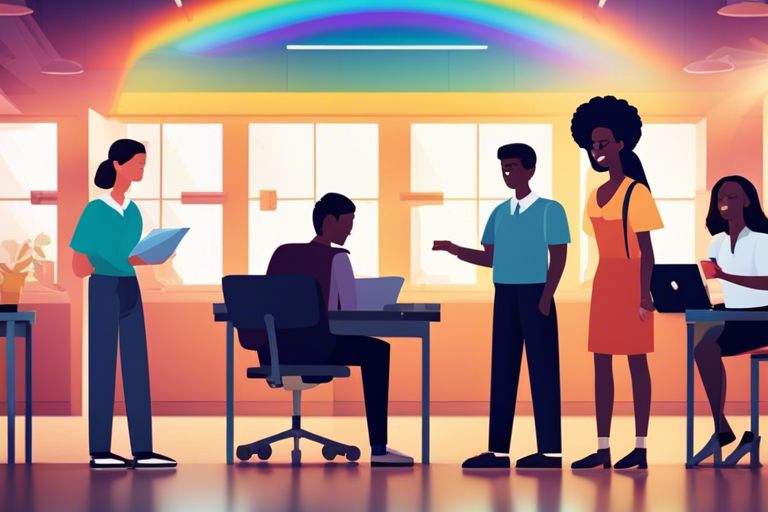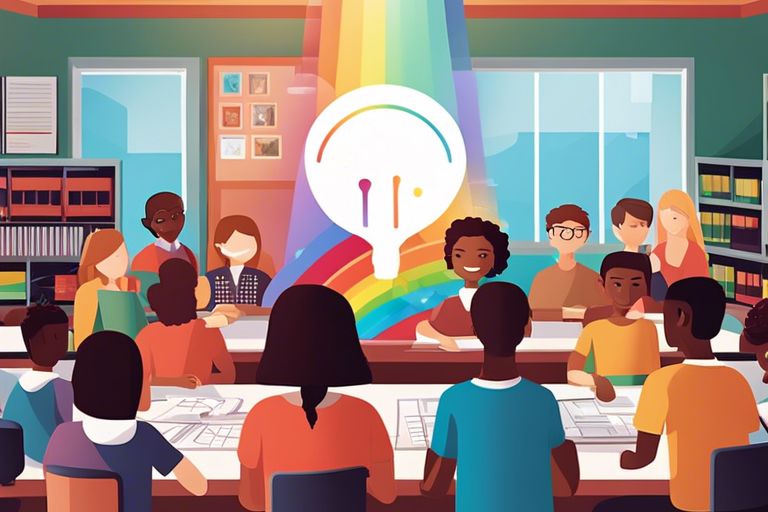Neurodiversity refers to the wide range of differences in how our brains work, including conditions such as autism, ADHD, dyslexia, and more. In the educational setting, it is crucial to embrace neurodiversity and implement strategies for inclusion to ensure all students can thrive. Ignoring the needs of neurodiverse students can lead to underachievement, mental health issues, and feelings of exclusion. By adopting inclusive teaching practices, providing appropriate support, and promoting understanding and acceptance among peers, schools can create an environment where every student has the opportunity to succeed. This blog post will explore key strategies to support neurodiversity in education and the positive impact it can have on individuals and the wider community.
Key Takeaways:
- Understanding neurodiversity is crucial in creating inclusive education environments.
- Implementing individualised support plans can greatly benefit neurodiverse students.
- Providing training for teachers and staff is essential for effectively supporting neurodiversity in education.
Recognising Neurodiversity in the Classroom
Creating an inclusive classroom environment begins with recognising the diverse range of learning styles and abilities present among students. This chapter focuses on the importance of identifying neurodiversity in the classroom and embracing these differences to support all learners effectively.
Identification and Assessment
Identification and assessment of neurodiversity in the classroom is crucial for providing appropriate support to students. Teachers can look out for signs such as difficulties with attention, social interactions, communication, or academic tasks. Collaboration with special educational needs coordinators, psychologists, and other professionals can lead to a holistic understanding of each student’s needs. This process allows for personalised support plans to be developed, ensuring that all students have equal opportunities to succeed.
Embracing Different Learning Styles
Embracing different learning styles is essential for creating an inclusive learning environment where all students can thrive. By understanding and accommodating various learning preferences, teachers can engage students more effectively and enhance their learning experiences. Visual, auditory, kinesthetic, and reading/writing learners all have unique strengths that can be leveraged to foster success in the classroom.
Teachers can employ a variety of teaching methods and tools to cater to different learning styles, such as incorporating visual aids, hands-on activities, group discussions, and technology-based resources. By embracing diversity in learning styles, educators can cater to the individual needs of each student and create a more supportive and enriching educational experience.
Developing an Inclusive Curriculum
Creating an inclusive curriculum is crucial for supporting neurodiversity in education. By designing a curriculum that caters to the diverse learning needs of all students, educators can ensure that every individual has the opportunity to thrive academically and reach their full potential.
Integrating Universal Design for Learning (UDL)
Integrating Universal Design for Learning (UDL) principles into the curriculum is essential for accommodating different learning styles and abilities. UDL focuses on providing multiple means of representation, engagement, and expression to cater to a wide range of learners. By incorporating UDL into teaching practices, educators can create a more accessible and inclusive learning environment for all students.
UDL promotes flexibility and personalised learning experiences, allowing students to demonstrate their understanding in various ways. This approach not only benefits neurodiverse students but enhances the overall learning experience for the entire class. By embracing UDL, educators can empower students to succeed by providing them with the tools and support they need to excel in their studies.
Tailoring Teaching Methods for Diverse Needs
Tailoring Teaching Methods for Diverse Needs involves customising teaching strategies to meet the individual requirements of students with diverse learning needs. This approach recognises that each student learns differently and may require specific adaptations to fully engage with the curriculum.
By tailoring teaching methods for diverse needs, educators can address the unique challenges that neurodiverse students may face in the classroom. This personalised approach ensures that all students have the opportunity to learn effectively and participate actively in their education, fostering a supportive and inclusive learning environment.

Creating a Supportive School Environment
In order to support neurodiversity in education, it is crucial to create a school environment that is inclusive and supportive of all students. This involves implementing strategies that cater to the diverse needs of learners and promote a sense of belonging and acceptance.
Training for Educators and Staff
Providing training for educators and staff is essential in creating a supportive school environment for neurodiverse students. This training should focus on understanding different neurodivergent conditions, effective teaching strategies, and adjustments that can be made to cater to individual needs. By equipping educators and staff with the necessary knowledge and skills, they can better support neurodiverse students and create an inclusive learning environment.
Fostering Peer Understanding and Acceptance
Fostering peer understanding and acceptance is crucial in promoting a supportive school environment for neurodiverse students. Encouraging empathy and acceptance among peers can help reduce stigma and create a more inclusive school community. Peer education programmes and activities can help raise awareness about neurodiversity and promote positive interactions among students.
Additionally, creating opportunities for neurodiverse students to engage with their peers in collaborative activities can help break down barriers and promote acceptance and understanding among students. Through peer-supported initiatives, students can learn from each other and cultivate a culture of empathy and inclusivity within the school.

Implementing Assistive Technologies and Resources
Technological Tools for Learning
Technology has revolutionised the way we approach education, particularly for students with neurodiversity. Assistive technologies such as speech-to-text software, mind-mapping tools, and interactive whiteboards can significantly enhance the learning experience for neurodiverse students. These tools help in reducing barriers to learning and improving accessibility to educational content.
Customisable learning platforms and adaptive software are invaluable resources for educators working with neurodiverse students. These tools can provide personalised learning experiences tailored to individual needs, promoting engagement and academic success. By integrating assistive technologies effectively, educational institutions can empower students with neurodiversity to thrive in their learning journeys.
Allocating Resources and Support Services
Ensuring adequate resources and support services are crucial for creating an inclusive educational environment. From providing specialised training for teachers to employing learning support assistants, allocating resources for neurodiverse students is essential. Access to assistive technology and individualised support can make a significant difference in the academic achievement and overall well-being of these learners.
In addition to technical tools, allocating resources and support services involves fostering a collaborative and responsive school community. This collaborative effort among educators, parents, and specialists can enhance the learning environment and create a supportive network for students with neurodiversity.

Collaboration and Community Involvement
Collaboration and community involvement are vital aspects of supporting neurodiversity in education. By working together with parents, caregivers, and specialist organisations, educators can create a more inclusive and supportive environment for neurodiverse students.
Engaging with Parents and Caregivers
Engaging with parents and caregivers is crucial for understanding the unique needs and strengths of neurodiverse students. By building strong partnerships with families, educators can gain valuable insights that can inform their teaching strategies. Regular communication, open dialogue, and collaboration can help ensure that the needs of neurodiverse students are met both at school and at home.
Building Partnerships with Specialist Organizations
Building partnerships with specialist organisations that focus on neurodiversity can provide educators with access to valuable resources, training, and expertise in supporting neurodiverse students. These organisations can offer insights into best practices, innovative strategies, and the latest research in the field of neurodiversity. By collaborating with specialist organisations, educators can enhance their knowledge and skills in supporting neurodiverse students effectively.
Furthermore, partnerships with specialist organisations can help educators stay updated on the latest developments in the field of neurodiversity and access support networks that can provide guidance and assistance when working with neurodiverse students. Establishing strong partnerships with these organisations can empower educators to create a more inclusive and supportive learning environment for all students.
Policy and Advocacy for Change
In the realm of education, it is crucial to have solid policy frameworks in place that support the inclusion of neurodiverse students. Policy plays a significant role in shaping the educational landscape and ensuring that the needs of all learners are met. Advocacy also plays a vital role in driving change and promoting a more inclusive environment for neurodiverse individuals within the education system.
Legal Frameworks and Rights
Legal frameworks such as the Equality Act 2010 in the UK and the Americans with Disabilities Act in the US provide a foundation for protecting the rights of neurodiverse individuals in education. These laws outline provisions for reasonable adjustments to be made to accommodate diverse learning needs and ensure that students are not discriminated against on the basis of their neurodiversity.
Advocating for Systemic Change in Education
Advocating for systemic change in education involves pushing for inclusivity policies that promote diversity and equity within educational institutions. This can include advocating for increased training for educators on neurodiversity, implementation of neurodiverse-friendly teaching practices, and promotion of a culture of acceptance and understanding within schools.
By advocating for systemic change in education, we can create a more inclusive and supportive environment for neurodiverse students, helping them thrive academically and socially. It is essential to continue pushing for policy reforms and advocating for the rights of neurodiverse individuals to ensure that they receive the support and accommodations they need to succeed.
Supporting Neurodiversity in Education – Strategies for Inclusion
Embracing neurodiversity in education is crucial for creating an inclusive and supportive learning environment for all students. By implementing strategies that cater to the diverse needs of neurodiverse individuals, such as providing alternative forms of communication, flexible learning methods, and tailored support, schools can ensure that every student has the opportunity to thrive academically and socially. It is essential for educational institutions to promote acceptance, understanding, and accommodation to celebrate the unique strengths and capabilities of neurodiverse students. Through a holistic and inclusive approach to education, we can empower all individuals to reach their full potential and contribute positively to society.
FAQ
Q: What is neurodiversity?
A: Neurodiversity is the concept that neurological differences, such as autism and ADHD, are natural variations of the human brain and should be recognised and respected as valid forms of diversity.
Q: Why is supporting neurodiversity important in education?
A: Supporting neurodiversity in education is crucial to creating an inclusive learning environment where all students can thrive and reach their full potential.
Q: What are some strategies for supporting neurodiversity in education?
A: Strategies for supporting neurodiversity in education include providing individualised support, promoting acceptance and understanding, and implementing universal design principles.
Q: How can teachers create inclusive classrooms for neurodiverse students?
A: Teachers can create inclusive classrooms for neurodiverse students by embracing diversity, fostering a culture of acceptance, providing differentiated instruction, and offering assistive technologies.
Q: What are the benefits of incorporating neurodiversity in educational settings?
A: Incorporating neurodiversity in educational settings can lead to increased academic success, improved social-emotional development, and a more positive school culture for all students.
Q: How can parents support neurodiverse children in their education?
A: Parents can support neurodiverse children in their education by communicating openly with teachers, advocating for their child’s needs, and seeking out resources and support networks.
Q: Where can educators find additional resources for supporting neurodiversity in education?
A: Educators can find additional resources for supporting neurodiversity in education from organisations, websites, and professional development opportunities dedicated to promoting inclusive practices and supporting neurodiverse students.







